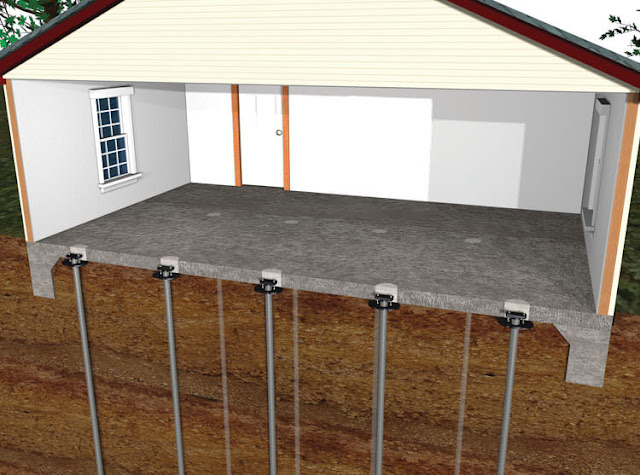House Sinking Foundation Repair: The Complete Guide
April 09, 2025Have you noticed unexpected cracks streaking across your walls? Do your doors suddenly stick, refusing to close as they used to? If you’ve been scratching your head over these issues, you might be dealing with a sinking foundation. This topic often comes with a sense of urgency, as the structural integrity of your home is at stake. The good news is a bit of knowledge goes a long way towards giving you peace of mind.
In this post, we’ll examine why a stable foundation is so vital, how to spot the earliest warning signs, and what might cause your home’s base to shift in the first place. We’ll explore different repair methods and discuss key questions like, “Is it safe to live in a house with a sinking foundation?” and “Will insurance cover foundation repairs in Australia?” By the end, you’ll have a clearer idea of which house sinking foundation repair techniques could work best for your situation.
Overview of Sinking Foundation Repair
Sinking foundation repair is a broad term for any technique aiming to level, support, or stabilise a home’s foundation. These methods may involve underpinning, injections, or jacking processes designed to lift or reinforce parts of the foundation that have settled unevenly.
At a basic level, the goal is to shift load-bearing responsibility back onto solid ground. This often includes inserting specialised piers beneath the foundation or pumping a material under the slab to fill gaps and provide added support. In other cases, tackling drainage issues, rerouting water, or installing moisture barriers can address the root causes of foundation settlement.
Recognising the Signs of A Sinking Foundation
One of the trickiest parts of house sinking foundation repair is figuring out whether you even need it. Subtle signs can creep in over time, so keep your eyes peeled for anything that seems out of the ordinary.
Gaps Around Window And Door Frames
Gaps that seem to expand are cause for concern. If the gap near a corner of a window frame grows over time, it may signify the foundation is losing its levelness. While older homes might show minor separation due to age, new or widening gaps indicate that the ground below is shifting more dramatically.
Common Causes of Foundation Sinking
Your foundation may sink for a multitude of reasons. Some revolve around soil conditions, while others relate to construction quality and water issues. Identifying the cause is key to selecting a successful fix.
Soil Movement And Settlement
Most Australian homes stand on soil that can shift with moisture changes. Clay-rich soil, in particular, expands when wet and contracts as it dries. Because of this natural swelling and shrinking, the foundation might shift out of place. Over time, these repetitive changes can weaken the soil’s ability to support your home.
Extreme Weather And Moisture Fluctuations
Droughts cause soil to contract, creating empty pockets beneath a foundation. Heavy rainfall, meanwhile, can over-saturate the soil, turning it into a soggy mess. The constant fluctuation weakens stability, making your foundation more prone to movement. In areas prone to floods or cyclones, waterlogging can cause even greater shifts.
Poor Construction Or Drainage
If the foundation wasn’t laid on properly compacted soil, problems can pop up years later. Not to mention, insufficient drainage around the property allows water to pool close to the footing, washing away supporting soil. Small oversights in construction—like failing to test soil conditions—can morph into major headaches down the line.
Plumbing Leaks And Underground Water Issues
Hidden plumbing leaks under or beside the foundation can erode the soil. Over time, a slow leak from a pipe or sewer line may moisten the surrounding soil and reduce its load-bearing capacity. If the water issue goes unnoticed, the damp soil compresses, leading to foundation movement and the signs you recognise around your home.
House Sinking Foundation Repair Methods
Different problems call for different fixes. Work with an experienced professional who can match the repair method to the specific conditions of your home. Below are some common techniques you might consider.
Underpinning (Piering, Screw Piers, and Concrete Piers)
Underpinning strengthens an existing foundation by extending it deeper into more stable soil. Modern approaches might involve steel piering, where adjustable piers are driven into the ground until they reach a reliable layer. Screw piers, sometimes called helical piers, literally “screw” into the soil and provide support. In older methods, contractors used concrete piers set beneath the footing. Underpinning is often a comprehensive route, as it works well in a variety of soil conditions and can offer a long-term solution.
Slab Jacking and Mud Jacking
Slab jacking (often known as mud jacking) involves injecting a specialised grout mixture underneath a sunken slab to lift it back into place. The injected material expands, filling the gaps and creating a stable platform for the foundation. This method tends to be quicker than some alternatives, and homeowners often prefer it if their foundation problems are confined to specific areas. However, success depends on accurately gauging how much material is needed and targeting the right spots.
Resin Injections
Resin injections use high-density polyurethane, which expands as it’s injected beneath the slab. Much like mud jacking, this approach raises the sunken sections from below. The advantage is that resin can be more lightweight and requires smaller drill holes to access the underside of the foundation. It’s often used in tight or complex spaces. One thing to note is that resin injections must be carried out by trained professionals to ensure precise placement and avoid over-lifting certain parts of the house.
Drainage and Soil Stabilisation
Sometimes the best “repair” is preventing further damage by controlling moisture. Improving drainage around your home could involve installing better gutters, downspouts, or grading the soil so water flows away. Soil stabilisation treatments can involve chemical injections or adding materials to improve soil density. These steps might not physically lift your home, but they can prevent future settlement, especially when caught early.
Choosing the Right Repair Solution
Selecting the proper method is never a one-size-fits-all decision. You must consider factors such as the severity of damage, the local soil composition, and building regulations in your area.
Assessing the Extent of Damage
Before committing to any repair, it’s advisable to get a thorough inspection. A structural engineer or house sinking foundation repair specialist can measure the levelness of floors, analyse cracks, and identify water-related issues. The scope of damage often dictates whether a simple fix (like resin injections) will suffice or if extensive underpinning is necessary.
Consulting with Structural Engineers
While foundation repair companies offer valuable insights, structural engineers can provide impartial advice. These seasoned professionals will confirm any underlying structural deficiencies and suggest scientifically grounded options. Having an engineer’s report can give you confidence that the chosen repair method is genuinely the right approach.
Finding a Reliable Foundation Repair Specialist
Choosing the right professional gives you confidence that you’re making the best long-term decision for your home. A little research and preparation can help you avoid costly mistakes.
Qualifications and Experience to Look For
Check whether the company or individual is qualified and has a great understanding of similar projects in your region. Do they carry relevant licences? Have they completed comprehensive training in underpinning, drainage improvements, or resin injection? A track record of satisfied clients is a good sign that you’ll be in capable hands.
Ensuring Quality and Warranties
House sinking foundation repair can be significant, financially and structurally. So, don’t hesitate to get multiple quotes, read reviews, and talk to previous customers. If a repair specialist promises a lifetime warranty, ask about the fine print. Some warranties may only remain valid if you maintain specific conditions, such as stable drainage or routine checks.
Conclusion
You’ve just explored the most important elements of house sinking foundation repair, from spotting the warning signs early to choosing the right fix for your situation. By learning about causes like soil movement, water leaks, and poor construction, you gain a clearer picture of how your home’s foundation shifts in the first place. Armed with this knowledge, you’re better prepared to pick a repair solution that keeps your home on solid ground for years.




0 comments